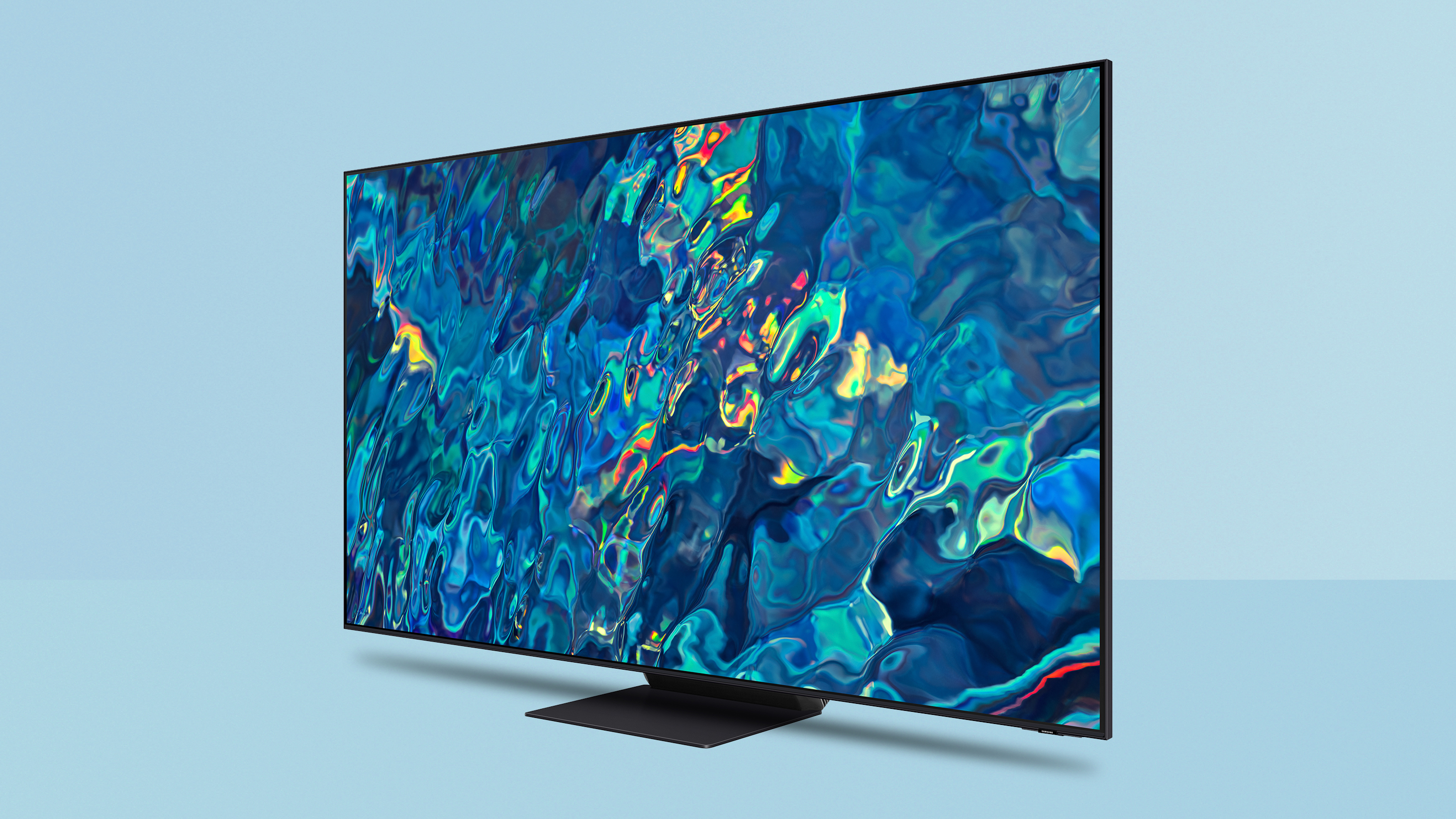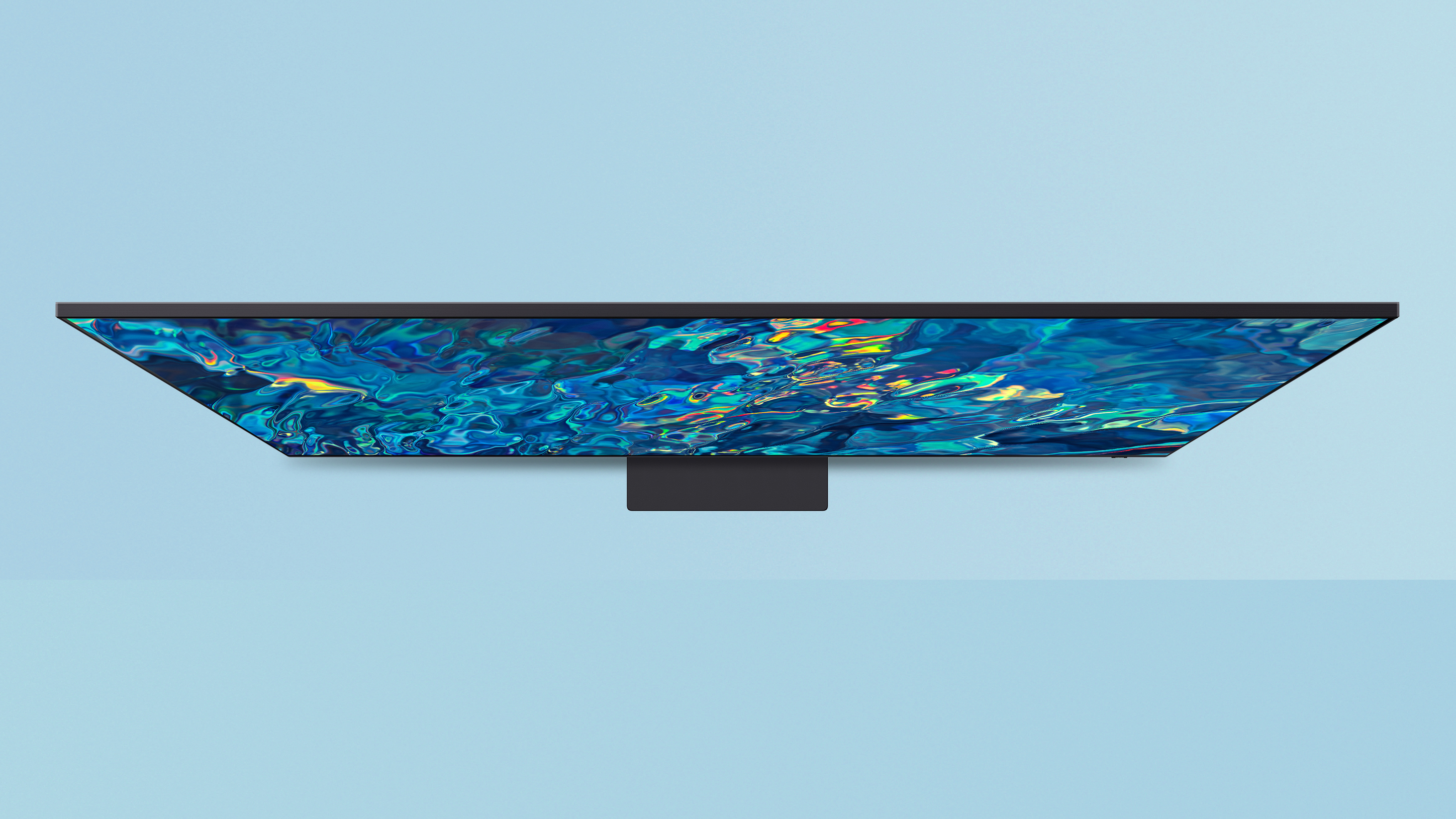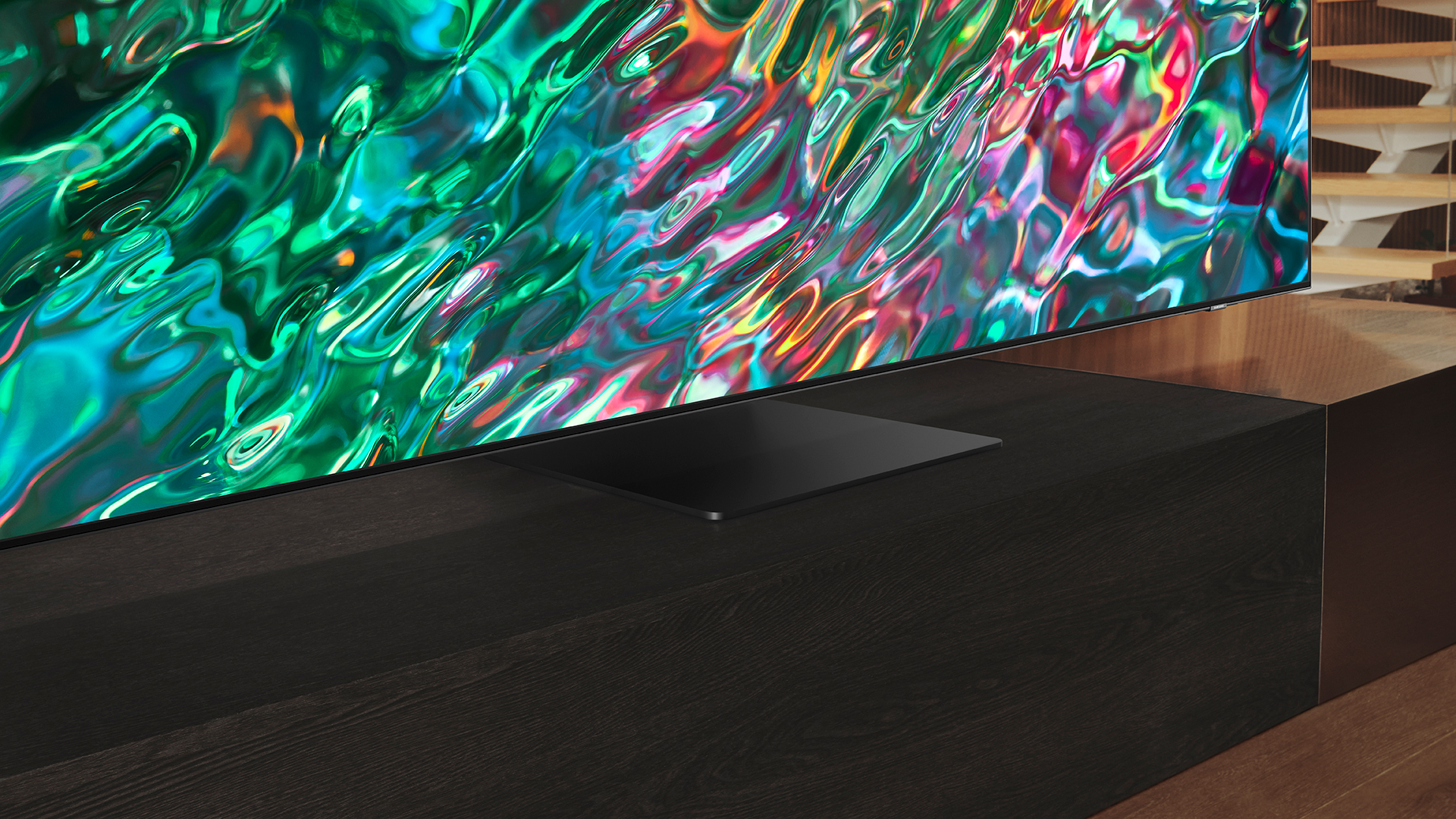Samsung QN95B (65QN95B) review: the best 4K TV from Samsung yet
The Samsung QN95B refines the awesome picture power of mini-LED to create something mind-blowing



The Samsung QN95A takes the already fantastic image quality of Neo QLED and cranks it up even further, somehow. The level of clarity is realistic beyond reason, and the HDR performance is dazzling – literally, in some cases. Add in its beautiful slim design and class-leading gaming features, and you've got the ultimate all-rounder TV. Movies look wonderful even in daylight, games are responsive, and even the sound is good… it's a worthy flagship 4K set.
-
+
Stunningly bright and intense HDR pictures
-
+
Excellent 4K sharpness and clarity
-
+
Strong streaming app support
-
+
Comprehensive gaming features and support
-
+
Sophisticated Infinity design
-
-
New smart interface is a misstep
-
-
Backlight clouding from wide viewing angles
-
-
No 8K support
-
-
Default settings cause artefacts
-
-
No Dolby Vision support
Why you can trust T3

In this Samsung QN95B review, we're looking at the company's flagship 4K TV for 2022, powered by second-generation Neo QLED screen tech. Using the power of a mini-LED backlight and the most advanced image processing Samsung has to offer, the aim here is to deliver HDR like you've never seen, perfect detail, and stunning colours.
And the Samsung QN95A delivers on all these promises, despite last year's models setting a ridiculously high bar. The extra light control enabled by illuminating their screens using much smaller LEDs led to unprecedented levels of LCD picture quality, the highest-end 8K version topped our list of the best TVs available that year.
In fact, arguably the only problem with last year's Samsung’s Neo QLED debutantes was that they were so good right out of the gate that we couldn’t help but find ourselves wondering where else Samsung might be able to take them in 2022.
Of course, there's always room to grow, and the Samsung QN95B has immediately staked a claim to not only be one of the best Samsung TVs but one of the best overall… albeit, at a price.
We tested the 65-inch Samsung 65QN95B model for this review.
Samsung QN95B review: price & release date
The Samsung QN95B launched in March 2022 in the UK and Europe. In the US, this particular model isn't available, with the very similar Samsung QN90B filling its slot instead.
It will set you back £2,599 for the 55-inch version, £3,499 for the 65-inch version we tested, £4,699 for the 75-inch version, and £6,399 for the 85-inch version. It's worth checking our list of Samsung discount codes to see if you can pick up a bargain.
These prices immediately establish it as a premium TV. In fact, it’s Samsung’s most expensive 4K 65-inch TV for 2022 – something that comes as quite a surprise given that Samsung will also be launching TVs using brand new Quantum Dot OLED technology in the next month or two.
It had been assumed before Samsung’s new range was fully revealed that the new QD-OLED crossover technology would sit at the top of the brand’s 2022 range, but actually it turns out that the S95B QD-OLED TV is priced lower than the QN95B Mini LED TV. This surely shows pretty clearly that Samsung thinks its flagship 4K Mini LED TV is superior to its new QD-OLED offering.

Samsung QN95B review: Features & what's new
Looking for evidence of just why Samsung might be so bullish about the QN95B, we suspect the answer lies in its brightness. Our own measurements found it capable of dazzling your retinas with nearly 2,900 nits at a time where even the current best OLED TVs are only just nudging beyond 1,000 nits. We don’t know yet how bright Samsung’s QD-OLEDs might get, but early word suggests it won’t be anything like as bright as the QN95B.
Brightness has become a much bigger deal than it used to be with the arrival of high dynamic range picture technologies. It’s not, though, the only thing that contributes to a good HDR experience. HDR is more about light range than just more brightness, so a convincing HDR display will also deliver good black levels. Which is where Samsung’s application of local dimming to the QN95B’s Mini LED technology comes in.
Last year’s 65-inch Samsung QN95A combined its mini-LED lighting with 720 independently controllable dimming zones, and the 65-inch QN95B does… exactly the same. This could be seen as a disappointment, were it not for a cool new feature called Shape Adaptive Light Control. This is able to essentially adjust the ‘shape’ of the light created by each separate dimming zone so that, for instance, a zone with a bright object at its centre could darken towards its edges to help it blend into a darker background being delivered by a neighbouring zone.
This should reduce the amount of backlight ‘blooming’ around bright highlights beyond even what having as many as 720 dimming zones can do.
Another key picture improvement includes a leg up for Samsung’s AI-inspired processor that now sees it drawing on the combined learned ‘wisdom’ of a remarkable 20 separate neural networks when deciding how best to make images (including, most notably, upscaled HD images) appear. The QN95B’s brainpower is now so potent, in fact, that Samsung has been able to update image processing to 14 bits from the previous 12 bits, which should yield smoother colour blends and improved greyscale management/shadow detail reproduction.
Note that the panel, however, remains 10 bit. There are still no commercially available native 12-bit TVs.
One last great new picture touch Samsung has included for 2022 is Auto Calibration, which lets you achieve a startlingly effective calibration to industry standards using just your mobile phone and some test signals from the TV. Pro calibrators may argue (as they need to, really…) that they can still get a bit more accuracy with their own more sensitive and sophisticated equipment, but I think the Auto Cal system will be more than good enough for most people. Especially considering it costs you no more than a few minutes of your time.
The QN95B is as big on gaming as it is on video. All four of its HDMI ports can handle the latest 4K at 120Hz and variable refresh rate features – including the AMD Freesync Premium Pro and (although it’s not officially stated) Nvidia G-Sync versions. The Game preset, meanwhile, can get input lag down to just 10.4ms – though handily Samsung provides options for trading a little more lag for a few more picture enhancement features if a game you’re playing doesn’t depend on lightning-fast reactions.
There’s even a Game Dashboard you can call up when the TV is in Game mode that provides you with streamlined access to game-related image information and settings.
Samsung hasn’t just been busy working on the QN95B’s picture features. It’s also improved its Object Tracking Sound (OTS) system that ranges speakers around the TV’s bodywork to create a larger, more accurately detailed soundstage by adding up-firing drivers. This dovetails neatly with the QN95B marking the first time Samsung has introduced Dolby Atmos decoding to one of its TVs.
Samsung has revamped its Tizen smart system for the 2022 TV season, too. Though as we’ll see in the usability section later, while this is excellent in terms of the amount of streaming services it covers, its new interface is a bit of a disaster.

Samsung QN95B review: Picture quality
Samsung’s mini-LED debutantes last year were so good they instantly changed our expectations of what LCD TVs were capable of. The QN95B doesn't deliver quite the same leap forwards, but it's clearly still significantly better than its predecessor.
The key to this improvement is the Shape Adaptive Light Control system. Being able to ‘shape’ the way light is used across individual dimming zones means the TV doesn’t need to dim stand-out bright points as much as it predecessor did to avoid backlight blooming. HDR pictures therefore look more consistent and reveal more of the immense contrast range HDR is capable of.
This isn’t to say that the QN95B doesn’t still sometimes dim stand-out bright picture elements a bit if they appear against extremely dark backgrounds. In particular, there’s a size limit to what the Shape Adaptive Light Control system and local dimming can do. So if a stand-out bright point is particularly small, it can still end up getting dimmed quite heavily.
The fact that the size and regularity of the bright point dimming have both been greatly reduced, though, has a really startling effect on both how punchy and how immersive the QN95B’s pictures typically are, even with the most extreme HDR content.
As hoped, the other thing the Shape Adaptive Light Control does is better feather the light at the edges of one dimming zone into the light at the edge of its neighbours. This further reduces the appearance of obvious areas of backlight clouding and blocking that you usually see with LED TVs that use direct lighting and local dimming. In fact, when you’re viewing the TV from reasonably head on, at least, backlight clouding really isn’t an issue at all.
This achievement becomes all the more remarkable when you recall that the screen can deliver nearly 2,900 nits of peak brightness in its Dynamic preset (measured on a white HDR box covering 10% of the screen). Most LED TVs can’t get close to this level of brightness either, and even those that do would almost certainly not be able to combine it with the remarkably deep, neutral black colours the QN95B is able to plumb.
Black levels in the Dynamic and Standard presets really do resemble the sort of thing we’d normally expect an OLED TV to be able to achieve. Just as importantly, the QN95B is significantly better than its mini-LED predecessor when it comes to showing shadow details in dark areas. It’s not absolutely immune to so-called black crush in its Standard or Dynamic presets, to be clear, but areas of dark scenes that look unnaturally hollow occur much less often.
As you’d hope with a TV that combines a Quantum Dot colour system with extreme brightness and contrast, the QN95B’s colours are nothing short of dazzling. Colour volume is extreme, with no pallidness kicking in even in the very brightest parts of the picture, while at the same time the improved processing does away with any trace of unnatural colour banding or blocking.
In fact, colour tones are reproduced so finely that they prove a perfect pixel by pixel match for the screen’s native resolution, joining the precision of Samsung’s processing in producing pictures that look ultra-sharp even by premium 4K TV standards.
While pictures inevitably look their best with native 4K content, the QN95B’s upscaling of HD and even SD sources is excellent too. Even better than it was on last year’s already excellent Samsung premium 4K TVs – especially when it comes to spotting the difference between unwanted source noise and actual picture information when it’s working out how the millions of extra pixels it’s creating should look.
Motion is handled well, too. Judder is a little strong without motion processing turned on, but not substantially so. And the Custom Picture Clarity mode with judder and blur reduction set to level three or four can remove that slight judder without making the image look unnaturally smooth or creating the distracting processing side effects that Samsung’s default motion processing settings frustratingly suffer with.
As long as you fire the screen up a few minutes before you want to use it, giving its LCD array time to warm up enough to avoid smearing, the QN95B is a brilliant gaming monitor. Its brightness, intense colours, fast response time, and new gaming dashboard make it a constant pleasure to game on.
Gaming sources also benefit the most, actually, from the massive backlight control improvements delivered by the new Shape Adaptive Light Control feature, with significantly less backlight blooming when playing HDR titles.
Aside from the default motion processing issues and occasional residual black crush moments, there are a few other small issues with the Samsung QN95B’s pictures. It doesn’t support the popular Dolby Vision HDR format, for starters; though you do get HDR10, HDR10+ and HLG support.
Its otherwise invisible blooming can become much more noticeable if you have to watch the TV from much of an angle, too, and black levels are less impressive using the Movie or Filmmaker mode picture presets (though manually tweaking the local dimming setting can help the Movie mode setting in this respect).
Finally, the Dynamic preset comes on so strong at times that it can become uncomfortable to watch. So our advice would be that you don’t use it.

Samsung QN95B review: Sound quality
The 65QN95B’s combination of Samsung’s Object Tracking Sound and new Dolby Atmos support works well, especially with the new up-firing drivers increasing the sense of verticality in the mix in a bid to represent Dolby Atmos’s height/overhead channels. Feed the QN95B a Dolby Atmos soundtrack, and you immediately notice an increase in the clarity and scale of the TV’s sound compared to plainer soundtracks.
The OTS system still works well with non-Atmos sources too, with the positioning of specific effects on screen feeling so accurate at times that you start to think there must be a series of speakers somehow built into the panel itself.
While it’s clever at positioning effects, though, the QN95B lacks a little room-filling impact compared with the best rival premium TVs. The audio action doesn’t really drive forward, and despite the presence of an eye-catching array of eight mid-range drivers ranged along the bottom of the rear side, bass doesn’t dip quite as low we’d like.
To sum it up, the sound is crisp, clear and detailed, but sounds a little restrained and hemmed in when the going gets tough. Really, you'll still want to pair it with one of the best soundbars for Samsung TVs, or one of the best surround sound systems if you the sound to match the images for scale.

Samsung QN95B review: Design & usability
Few if any large TVs around today are capable of hiding in plain sight quite as successfully as the QN95B. For starters, the frame around the so-called ‘Infinity’ screen really is just the thinnest sliver of silvery metal, making it all but invisible when you’re watching the TV.
Samsung’s Ambient Mode, meanwhile, lets you run artworks or relaxing video content on the screen when you’re not watching it, so you never have to be left with a gaping black hole in your room.
The way the rear panel is as flat as the front creates a striking monolithic impression, and this combines with a trimmer rear than last year’s equivalent model to underline the futuristic feel – as well as potentially making it a much better option for wall hanging. If you’d rather stick to a desktop set up, though, the centrally mounted stand is very stable and sturdy.
The QN95B boasts a new smart system and interface. It’s still based on Samsung’s Tizen engine, but it completely changes the layout from the system we’ve seen only small refinements of for the past couple of years.
For starters it shifts to a full-screen home page, rather than just superimposing a row or two of icons over the bottom of the image. And into that full screen interface it really goes to town on trying to come up with what sound on paper like creative ways of aggregating content into themes from many of the large number of streaming services it supports.
However, a large chunk of the new home screen is wasted on what’s essentially an advert, for starters. Also, the way the TV tries to collate content ultimately just ends up filling the screen with lots of obscure stuff that most people won’t care less about.
You can’t change the running order of the content shelves Samsung has come up with either, and the relationship between the picture and sound adjustment menus and the smart menus has become pretty inscrutable at times.
Essentially I spent most of my time with the new Tizen smart menus wishing there was an option to rewind the interface back to last year’s far simpler system – though I should add that Samsung’s strong voice recognition support does provide welcome short cuts past many of the new menus’ worst failings.
If you watch from external sources – one of the best 4K Blu-ray players, or a streaming box – then obviously this is less of a problem. But it's definitely a step backwards.
And speaking of external sources, Samsung has continued to use its delightful One Connect box in this set, which shifts the processing and connections to an external unit, meaning that the TV itself gets to remain super-thin. It also makes the connections more accessible than if they were on the back, and also makes it far easier to keep your cables tidy. It's a win all around.

Samsung QN95B review: Verdict
The QN95B is a stunning TV that delivers a major picture leap forward from its already excellent predecessor, despite not having the same kind of huge technical transformation we've seen in recent years.
The improved backlight control and ridiculous brightness makes this simply an astounding TV with HDR content, and it really makes the most of both movies and games.
With 2022 set to give us a whole host of TV innovations, Samsung needed to set a high bar with the QN95B. And happily that’s exactly what it’s done.
Samsung QN95B review: Also consider
The really big competitor here is the Samsung QN90B, mentioned above. You get most of the same screen technology, but with a simplified design (no One Connect box) and the less advanced Neo Quantum Processor 4K, you save a huge amount of money. You'll pay £1,799 for the 55-inch version, or £2,599 for the 65-inch version, for example.
If price isn't a factor, then the Samsung S95B QD-OLED TV will surely be the other hot competitor. Like the QN95B, you're getting the absolutely cutting edge of screen technology, with QD-OLED promising colours like no other screen has ever managed. It won't hit the same brightness levels as the QN95B, though its dark performance will be even better.
Along those same lines is the Sony A95K, which also uses the same QD-OLED panel as the Samsung S95B, but with Sony's image processing and sound tech, which is all absolutely top notch.
Sign up to the T3 newsletter for smarter living straight to your inbox
Get all the latest news, reviews, deals and buying guides on gorgeous tech, home and active products from the T3 experts
John Archer has been testing TVs and AV gear for over 25 years, having worked on Home Cinema Choice magazine. He's a contributor to Forbes, TechRadar, Trusted Reviews, Wired and many more places – if you've owned a TV in the last couple of decades, John's probably reviewed it somewhere. He's seen so many hot new technologies come and go, like tears in the rain.
-
 Netflix's fantasy action blockbuster returns in July, five years after huge original
Netflix's fantasy action blockbuster returns in July, five years after huge originalThe Old Guard 2 is on the way
By Max Freeman-Mills Published
-
 Your smart home just got easier to manage – thanks to Matter’s new update
Your smart home just got easier to manage – thanks to Matter’s new updateIt brings three exciting features with it
By Lizzie Wilmot Published
-
 Fünf Gründe, warum EA Sports FC 25 für mich eine große Verbesserung gegenüber FC 24 ist
Fünf Gründe, warum EA Sports FC 25 für mich eine große Verbesserung gegenüber FC 24 istEA tritt endlich aus dem FIFA-Schatten heraus
.By Rik Henderson Published